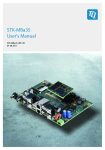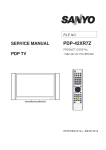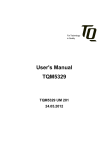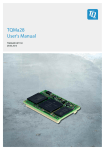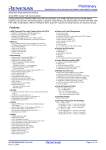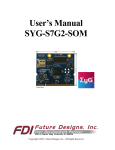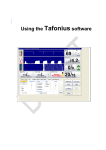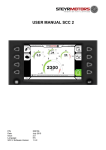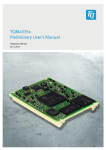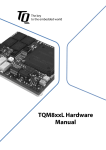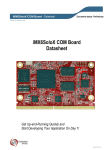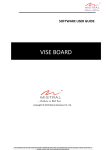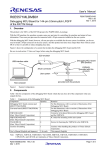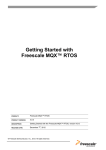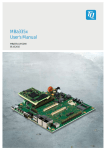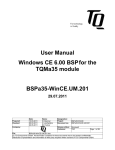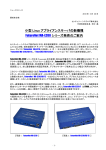Download TQMa35 User`s Manual - TQ
Transcript
TQMa35 User's Manual TQMa35 UM 103 28.03.2013 User's Manual l TQMa35 UM 103 l © 2013 by TQ-Group Page i Table of contents 1. 1.1 1.2 1.3 1.4 1.5 1.6 1.7 1.8 1.9 1.10 2. 3. 3.1 3.1.1 3.1.2 3.1.2.1 3.1.2.2 3.1.2.3 4. 4.1 4.1.1 4.1.2 4.1.2.1 4.1.2.2 4.1.2.3 4.1.3 4.1.3.1 4.1.3.2 4.1.3.3 4.1.4 4.2 4.3 4.3.1 4.3.1.1 4.3.1.2 4.3.1.3 4.3.1.4 ABOUT THIS MANUAL ...................................................................................................................... 1 Copyright ............................................................................................................................................. 1 Tips on safety ...................................................................................................................................... 1 Symbols and Typographic Conventions .................................................................................... 1 Handling and ESD tips ..................................................................................................................... 2 Registered trademarks..................................................................................................................... 2 Imprint .................................................................................................................................................. 3 Disclaimer ............................................................................................................................................ 3 Copyright and licence expenses................................................................................................... 3 Further applicable documents / presumed knowledge ....................................................... 4 Acronyms and definitions............................................................................................................... 5 BRIEF DESCRIPTION .......................................................................................................................... 7 TECHNICAL DATA .............................................................................................................................. 8 System architecture and functionality........................................................................................ 8 TQMa35 block diagram ................................................................................................................... 8 System functionality......................................................................................................................... 9 System components......................................................................................................................... 9 Interfaces ............................................................................................................................................. 9 Diagnosis LED ..................................................................................................................................... 9 ELECTRONICS SPECIFICATION ..................................................................................................... 10 Interfaces to other systems and devices .................................................................................. 10 Module connectors ......................................................................................................................... 10 Pin assignment................................................................................................................................. 11 Module connector X1 .................................................................................................................... 12 Module connector X2 .................................................................................................................... 13 Module connector X3 .................................................................................................................... 14 Pin description ................................................................................................................................. 15 Module connector X1 .................................................................................................................... 16 Module connector X2 .................................................................................................................... 20 Module connector X3 ................................................................................................................... 24 Electrical characteristics ................................................................................................................ 27 User's interfaces ............................................................................................................................... 28 System components....................................................................................................................... 28 Processor ............................................................................................................................................ 28 Boot modes ....................................................................................................................................... 31 Memory management ................................................................................................................... 33 Pin multiplexing .............................................................................................................................. 33 CPU-Errata ......................................................................................................................................... 33 Page ii User's Manual l TQMa35 UM 103 l © 2013 by TQ-Group Table of contents (continued) 4.3.2 4.3.2.1 4.3.2.2 4.3.2.3 4.3.2.4 4.3.3 4.3.4 4.3.5 4.3.6 4.3.7 4.3.7.1 4.3.7.2 4.3.8 4.3.8.1 4.3.8.2 4.3.9 4.3.10 4.3.10.1 4.3.10.2 4.3.10.3 4.3.10.4 4.3.10.5 4.3.10.6 4.3.10.7 4.3.10.8 4.3.10.9 4.3.11 4.3.12 4.3.13 4.3.14 4.3.15 4.3.16 4.3.17 4.3.18 Memory .............................................................................................................................................. 34 mDDR SDRAM .................................................................................................................................. 34 NOR flash............................................................................................................................................ 34 eMMC .................................................................................................................................................. 35 EEPROM .............................................................................................................................................. 36 WEIM bus .......................................................................................................................................... 36 RTC ....................................................................................................................................................... 37 Temperature sensor ....................................................................................................................... 37 SD card................................................................................................................................................ 37 Graphics interfaces ......................................................................................................................... 38 LCD bus .............................................................................................................................................. 38 Sensor interface ............................................................................................................................... 38 USB Hi-Speed .................................................................................................................................... 39 USB On-The-Go ................................................................................................................................ 39 USB Host............................................................................................................................................. 40 Ethernet .............................................................................................................................................. 41 Serial interfaces ................................................................................................................................ 42 UART1 / RS232 .................................................................................................................................. 42 UART2 ................................................................................................................................................. 43 UART3 ................................................................................................................................................. 43 I2C bus ................................................................................................................................................. 44 CAN ...................................................................................................................................................... 45 SPI1 ...................................................................................................................................................... 45 SPI2 ...................................................................................................................................................... 45 SSI ......................................................................................................................................................... 45 1-Wire .................................................................................................................................................. 46 PWM .................................................................................................................................................... 46 Keypad ................................................................................................................................................ 46 GPIO ..................................................................................................................................................... 46 Timer ................................................................................................................................................... 46 BDM/JTAG.......................................................................................................................................... 47 Power management ....................................................................................................................... 47 Voltage supervision ........................................................................................................................ 48 Backup supply .................................................................................................................................. 48 User's Manual l TQMa35 UM 103 l © 2013 by TQ-Group Page iii Table of contents (continued) 5. 6. 6.1 6.2 6.3 6.4 6.5 6.5.1 6.5.2 6.5.3 7. 7.1 7.2 7.3 7.4 7.5 7.6 7.6.1 7.6.2 7.6.3 8. 8.1 SOFTWARE SPECIFICATION .......................................................................................................... 49 MECHANICS SPECIFICATION ........................................................................................................ 49 General information ....................................................................................................................... 49 Dimensions and stacks heights................................................................................................... 49 Notes of treatment.......................................................................................................................... 50 Component placement ................................................................................................................. 51 Requirements for the higher-level system .............................................................................. 52 Protection against external effects ............................................................................................ 52 Thermal management ................................................................................................................... 52 Structural requirements ................................................................................................................ 52 SAFETY REQUIREMENTS AND PROTECTIVE REGULATIONS ................................................ 53 EMC requirements .......................................................................................................................... 53 ESD requirements............................................................................................................................ 53 Operational safety and personal security ................................................................................ 53 Climatic and operational conditions ......................................................................................... 53 Reliability and service life.............................................................................................................. 54 Environment protection................................................................................................................ 54 RoHS compliance ............................................................................................................................ 54 WEEE regulation .............................................................................................................................. 54 Other entries ..................................................................................................................................... 54 APPENDIX .......................................................................................................................................... 55 References ......................................................................................................................................... 55 Page iv User's Manual l TQMa35 UM 103 l © 2013 by TQ-Group Table directory Table 1: Table 2: Table 3: Table 4: Table 5: Table 6: Table 7: Table 8: Table 9: Table 10: Table 11: Table 12: Table 13: Table 14: Table 15: Table 16: Table 17: Table 18: Table 19: Table 20: Table 21: Table 22: Table 23: Table 24: Table 25: Table 26: Table 27: Table 28: Table 29: Terms and conventions ............................................................................................................. 1 Acronyms ....................................................................................................................................... 5 Module connectors used on the TQMa35 ......................................................................... 10 Suitable carrier board mating connectors......................................................................... 11 Pin assignment module connector X1 ............................................................................... 12 Pin assignment module connector X2 ............................................................................... 13 Pin assignment module connector X3 ............................................................................... 14 Pin description X1 ..................................................................................................................... 16 Pin description X2 ..................................................................................................................... 20 Pin description X3 ..................................................................................................................... 24 Electrical characteristics of digital I/Os ............................................................................... 27 Electrical characteristics of the physical signals .............................................................. 28 State of the Reset-LED ............................................................................................................. 28 Processor derivatives ............................................................................................................... 29 Configurable boot pins on the TQMa35 ............................................................................ 31 Possible boot mode configurations for the TQMa35 ..................................................... 32 External Memory allocation ................................................................................................... 33 Memory models mDDR SDRAM............................................................................................ 34 Memory model NOR flash....................................................................................................... 34 Memory model eMMC flash ................................................................................................... 35 Memory model EEPROM ......................................................................................................... 36 Parameter 32.768 kHz crystal oscillator.............................................................................. 37 Transfer modes SD interfaces ................................................................................................ 37 I2C device configuration .......................................................................................................... 44 Technical parameters module supply................................................................................. 47 Trigger levels TPS3801-01 ...................................................................................................... 48 Technical parameters backup input .................................................................................... 48 Height dimensions.................................................................................................................... 50 Further applicable documents.............................................................................................. 55 User's Manual l TQMa35 UM 103 l © 2013 by TQ-Group Page v Illustration directory Illustration 1: Illustration 2: Illustration 3: Illustration 4: Illustration 5: Illustration 6: Illustration 7: Illustration 8: Illustration 9: Illustration 10: Illustration 11: Illustration 12: Illustration 13: Illustration 14: Illustration 15: Illustration 16: Illustration 17: Illustration 18: Illustration 19: Illustration 20: TQMa35 block diagram .................................................................................................. 8 i.MX35 block diagram ................................................................................................... 29 Interface WEIM bus ........................................................................................................ 36 Interface LCD ................................................................................................................... 38 Interface CSI ..................................................................................................................... 38 Interface USB OTG .......................................................................................................... 39 USB Hi-Speed OTG workaround ................................................................................ 39 Interface USB host.......................................................................................................... 40 Interface Ethernet MII ................................................................................................... 41 Interface UART1 / RS232 .............................................................................................. 42 Interface UART2 .............................................................................................................. 43 Interface UART3 .............................................................................................................. 43 Interface I2C buses.......................................................................................................... 44 Interface SSI ..................................................................................................................... 45 Timing diagram of a GPIO wakeup interrupt ........................................................ 46 Interface BDM/JTAG ...................................................................................................... 47 Overall dimensions (top view through board)...................................................... 49 Stacks heights (not to scale) ....................................................................................... 49 Component placement top ........................................................................................ 51 Component placement bottom ................................................................................ 51 User's Manual l TQMa35 UM 103 l © 2013 by TQ-Group Page vi Revision history Rev. Date Name 100 Petz 30.03.2011 Pos. Document created 2 All 4.3.10.2 4.3.10.3 Petz Modification Power consumption corrected USB signal names corrected Syntax of signals RTS# and CTS# corrected Syntax of signals RTS# and CTS# corrected Information about gold-plating corrected Values for current consumption updated Values for current consumption updated Values for current consumption “Idle” and “Standby” added Reference (11) added 101 06.12.2011 102 24.05.2012 Petz Section 5 Link to Wiki added 103 28.03.2013 Petz All Typo Table 4 4.3.16 Table 25 Table 25 Table 29 User's Manual l TQMa35 UM 103 l © 2013 by TQ-Group 1. ABOUT THIS MANUAL 1.1 Copyright Page 1 Copyright protected © 2013 by TQ-Systems GmbH. This User’s Manual may not be copied, reproduced, translated, changed or distributed, completely or partially in electronic, machine readable, or in any other form without the written consent of TQ-Systems GmbH. 1.2 Tips on safety Improper or incorrect handling of the product can substantially reduce its life span. 1.3 Symbols and Typographic Conventions Table 1: Terms and conventions Symbol / Visual Cue Meaning This symbol represents the handling of electrostatic-sensitive modules and / or components. These components are often damaged / destroyed by the transmission of a voltage higher than about 50 V. A human body usually only experiences electrostatic discharges above approximately 3,000 V. This symbol indicates the possible use of voltages higher than 24 V. Please note the relevant statutory regulations in this regard. Noncompliance with these regulations can lead to serious damage to your health and cause damage / destruction of the component. This symbol indicates a possible source of danger. Acting against the procedure described can lead to possible damage to your health and / or cause damage / destruction of the material used. This symbol represents important details or aspects for working with TQ-products. Command This specification is used to state the complete file name with its corresponding extension. User's Manual l TQMa35 UM 103 l © 2013 by TQ-Group Page 2 1.4 Handling and ESD tips General handling of your TQ-products The TQ-product may only be used and serviced by certified personnel who have taken note of the information, the safety regulations in this document and all related rules and regulations. A general rule is: do not touch the TQ-product during operation. This is especially important when switching on, changing jumper settings or connecting other devices without ensuring beforehand that the power supply of the system has been switched off. Violation of this guideline may result in damage / destruction of the module and be dangerous to your health. Improper handling of your TQ-product would render the guarantee invalid. Proper ESD handling The electronic components of your TQ-product are sensitive to electrostatic discharge (ESD). Always wear antistatic clothing, use ESD-safe tools, packing materials etc., and operate your TQ-product in an ESD-safe environment. Especially when you switch modules on, change jumper settings, or connect other devices. 1.5 Registered trademarks TQ-Systems GmbH aims to adhere to the copyrights of all the used graphics and texts in all publications and strives to use original or license-free graphics and texts. All the brand names and trademarks mentioned in the publication, including those protected by a third party, unless specified otherwise in writing, are subjected to the specifications of the current copyright laws and the proprietary laws of the present registered proprietor without any limitation. One should conclude that brands and trademarks are protected through the rights of a third party. User's Manual l TQMa35 UM 103 l © 2013 by TQ-Group 1.6 Page 3 Imprint TQ-Systems GmbH Gut Delling, Mühlstraße 2 82229 Seefeld Tel: +49 (0) 8153 9308–0 Fax: +49 (0) 8153 9308–134 Email: [email protected] Web: http://www.tq-group.com/ 1.7 Disclaimer TQ-Systems GmbH does not guarantee that the information in this manual is up-to-date, correct, complete or of good quality. Nor does TQ-Systems assume guarantee for further usage of the information. Liability claims against TQ-Systems GmbH, referring to material or non-material related damages, caused due to usage or non-usage of the information given in the manual, or caused due to usage of erroneous or incomplete information, are exempted, as long as there is no proven, intentional or negligent fault of TQ-Systems GmbH. TQ-Systems GmbH explicitly reserves the rights to change or add to the contents of this manual or parts of it without special notification. 1.8 Copyright and licence expenses e xpenses The drivers and utilities for the used components as well as the BIOS are subject to the copyrights of the respective manufacturers. The licence conditions of the respective manufacturer are to be adhered to. Bootloader-licence expenses are paid by TQ and are included in the price. Licence expenses for the operating system and applications are not taken into consideration and must be separately calculated / declared. Page 4 1.9 User's Manual l TQMa35 UM 103 l © 2013 by TQ-Group Further applicable documents / presumed knowledge • Specifications and manual of the th e used modules: These documents describe the service, functionality and special characteristics of the used module (incl. BIOS). • Specifications of the used components: The manufacturer's specifications of the used components, for example Compact-Flash cards, are to be taken note of. They contain, if applicable, additional information that must be taken note of for safe and reliable operation. These documents are stored at TQ. • Chip errata: It is the user's responsibility to make sure all errata published by the manufacturer of each component are taken note of. The manufacturer’s advice should be followed. • Software behaviour: No warranty can be given, nor responsibility taken for any unexpected software behaviour due to deficient components. • General expertise: expertise: Expertise in electrical engineering / computer engineering is required for the installation and the use of the device. User's Manual l TQMa35 UM 103 l © 2013 by TQ-Group 1.10 Acronyms and definitions The following acronyms and abbreviations are used in this document: Table 2: Acronyms Acronym Meaning ARM® ATA BDM BGA BSP CAN CCD CE-ATA CMOS CPU DDR DNC ECC EEPROM EMC eMMC ESD FEC FR-4 GPIO GPU I/O IP00 IPU I2C JTAG LCD LED LSB LVTTL Mbps mDDR MIC MII Advanced RISC Machine Advanced Technology Attachment Background Debug Mode Ball Grid Array Board Support Package Controller Area Network Charge-Coupled Device Consumer Electronics-Advanced Technology Attachment Complementary Metal Oxide Semiconductor Central Processing Unit Double Data Rate Do Not Connect Error Checking and Correction Electrically Erasable Programmable Read-only Memory Electromagnetic Compatibility embedded MultiMediaCard (Flash) Electrostatic Discharge Fast Ethernet Controller Flame Retardant-4 General Purpose Input/Output Graphics Processor Unit Input/Output Ingress Protection 00 Image Processing Unit Inter-Integrated Circuit Joint Test Action Group Liquid Crystal Display Light Emitting Diode Least Significant Bit Low Voltage Transistor Transistor Logic Megabit per second mobile Double Data Rate Microphone Media-Independent Interface Page 5 User's Manual l TQMa35 UM 103 l © 2013 by TQ-Group Page 6 Table 2: Acronyms (continued) Acronym Meaning MMC MMCA MOZI MSB MTBF NAND NC NOR OTG PATA PCB PHY Ppm PSRAM PWM RAM RF RoHS ROM RTC SD SDIO SDRAM SMD SPI SRAM SSI UART UL ULPI USB USB-HS UTMI WEEE WEIM WP WVGA Multimedia Card MultiMediaCard Association Module extractor (Modulzieher) Most Significant Bit Mean operating Time Between Failures Not-and Not Connected Not-or On-The-Go Parallel ATA Printed Circuit Board Physical (Interface) Parts Per Million CellularRAM ™ Pulse Width Modulation Random Access Memory Radio Frequency Restriction of (the use of certain) Hazardous Substances Read-Only Memory Real-Time Clock Secure Digital Secure Digital Input/Output Synchronous Dynamic Random Access Memory Surface-Mounted Device Serial Peripheral Interface Static Random Access Memory Synchronous Serial Interface Universal Asynchronous Receiver/Transmitter Underwriters Laboratories Inc. UTMI+ Low Pin Interface Universal Serial Bus Universal Serial Bus - High Speed USB 2.0 Transceiver Macrocell Interface Waste Electrical and Electronic Equipment Wireless External Interface Module Write-Protection Wide Video Graphics Array (800 × 480) User's Manual l TQMa35 UM 103 l © 2013 by TQ-Group 2. Page 7 BRIEF DESCRIPTION The TQMa35 is a universal Minimodule with a Freescale ARM-CPU MCIMX35 (i.MX35). The ARM1136 core works with up to 532 MHz. The module extends the TQC product range and offers a well-balanced ratio between computing performance and graphics power. The module offers the following key functions and characteristics: • • • • • • • • • • • • • • • • • Freescale i.MX353 (ARM11 architecture), 532 MHz Integrated hardware acceleration for IPU and GPU All functional CPU pins are routed to module connectors Up to 128 MiB NOR Flash Up to 512 MiB mDDR-SDRAM eMMC flash (option) 1 × USB 2.0 Hi-Speed Host interface 1 × USB 2.0 Hi-Speed OTG Temperature sensor RTC EEPROM RS232-Transceiver on-board Single power supply: 3.3 V Low power consumption (typical 1 – 1.5 W) Dimensions: 54 × 44 mm2 Easy and cost-efficient carrier board development Long term available Since almost all functional pins of the processor (except SDRAM interface) are routed to the module connectors, there is a wide range of possible applications for the TQMa35. User's Manual l TQMa35 UM 103 l © 2013 by TQ-Group Page 8 3. TECHNICAL DATA 3.1 System architecture and functionality 3.1.1 TQMa35 block diagram 120-pin plug connector 80-pin plug connector Tyco 5353999-5 Tyco 5177985-3 USB-ULPI-PHY 3 x driver ISP1504C1 74 AVCH 16T 245ZQLR NOR-Flash (max. 128 MiB) PC28F256M29EWL USB OTG / CONFIG / SD1 / LCD / Sensor - IPU / SSI 4 / JTAG / PWM WEIM ESDRAMC USBH2 I2C2 CPU i.MX35 (2x) mDDR-RAM (max. 512 MiB) H5MS 2G22 MFR-J3M EEPROM (max . 64 Kibit) M24C64-WDW6TP RTC DS1339U-33+ UART1 ETH MII / SPI 1+2 / CAN 1+2 / I2C 1 / UART 2+3 / 4 x4 Keypad / 1-Wire / Timer / GPIOs SD3 Temp.-sensor RS232- driver MAX3222 0 R n.a. LM75CIMM-3 eMMC Flash (max . 4 GiB) THGBM1G4D1EBAI7 120-pin plug connector Tyco 5353999-5 Illustration 1: TQMa35 block diagram User's Manual l TQMa35 UM 103 l © 2013 by TQ-Group 3.1.2 System functionality 3.1.2.1 System components • • • • • • • • • • • • • 3.1.2.2 • • Processor (Freescale MCIMX35, ARM1136JF-S, 532 MHz, IPU and GPU) Crystal oscillators for the CPU (24 MHz and 24.576 MHz) mDDR-SDRAM (32 Bit, 133 MHz, up to 2 devices parallel with 256 MiB each) 1 NOR flash (16 Bit, up to 128 MiB) 2 eMMC NAND flash (up to 4 GiB, SD3 interface at X1 not usable) 3 EEPROM (via I2C, up to 64 Kibit) 3 Temperature sensor (via I2C) Separate RTC (via I2C, battery buffering possible) Crystal oscillator for RTC (32.768 kHz) RS232 driver (at UART1, RxD and TxD) USB-ULPI-PHY (Hi-Speed) Level converter (3.3 V VCCI/O for all signals at the module connectors) Power Management (Power-Up sequencing, voltage supervision, Boot mode configuration, Reset) Interfaces 2 × 120-pin module connector 1 × 80-pin module connector 3 A detailed overview of all available user interfaces can be found in section 4.1 on page 10. 3.1.2.3 • 1 2 3 Diagnosis LED Indication of reset condition Size of mDDR-SDRAM depends on placement option. Size of NOR-Flash depends on placement option. Depends on placement option. Page 9 User's Manual l TQMa35 UM 103 l © 2013 by TQ-Group Page 10 4. ELECTRONICS SPECIFICATION SPECIFICATION 4.1 Interfaces to other systems and devices The TQMa35 is connected to the carrier board with 240 pins on two module connectors, optionally with 320 pins on three connectors. The module is held in the connectors with a considerable retention force. To avoid damaging the modules’ connectors as well as the carrier board connectors while removing the module the use of an extraction tool is strongly recommended. (For more information, see section 6.3 on page 50). 4.1.1 Module connectors Table 3: Module connectors used on the TQMa35 Manufacturer / Part No. Description tyco / 5353999-5 − − − − 120-pin connector 0.8 mm pitch vertical –40 °C to +85 °C tyco 4 / 5177985-3 − − − − 80- pin connector 0.8 mm pitch vertical –40 °C to +85 °C The following table shows suitable mating connectors for the carrier board. 4 Depends on placement option. User's Manual l TQMa35 UM 103 l © 2013 by TQ-Group Table 4: Manufacturer Page 11 Suitable carrier board mating connectors Part No. No. of pins Plating Board to board distance (see Illustration 18) tyco 5177986-5 120 0.2 µm Gold 5 mm tyco 5-5177986-5 120 0.76 µm Gold 5 mm tyco 1-5177986-5 120 0.2 µm Gold 6 mm tyco 6-5177986-5 120 0.76 µm Gold 6 mm tyco 2-5177986-5 120 0.2 µm Gold 7 mm tyco -------------- 120 0.76 µm Gold 7 mm tyco 3-5177986-5 120 0.2 µm Gold 8 mm tyco 6123001-5 120 0.76 µm Gold 8 mm tyco 5177986-3 80 0.2 µm Gold 5 mm tyco 5-5177986-3 80 0.76 µm Gold 5 mm tyco 1-5177986-3 80 0.2 µm Gold 6 mm tyco 6-5177986-3 80 0.76 µm Gold 6 mm tyco 2-5177986-3 80 0.2 µm Gold 7 mm tyco -------------- 80 0.76 µm Gold 7 mm tyco 3-5177986-3 80 0.2 µm Gold 8 mm tyco 6123001-3 80 0.76 µm Gold 8 mm 4.1.2 Pin assignment When using the processor signals the multiple pin configurations by different processor-internal function units must be taken note of. The pins assignment listed in sections 4.1.2.1 to 4.1.2.3 refer to the corresponding standard BSP of TQ-Systems GmbH. User's Manual l TQMa35 UM 103 l © 2013 by TQ-Group Page 12 Module connector X1 Table 5: Group Power Power Power Power Power Power General clock Power GPIO Power GPIO Power 4x4 keypad Power 1-Wire SPI 1 Power SPI 1 Power Timer SD card 3 Power SD card 3 Power Ethernet MII Power Ethernet MII Power CAN 2 CAN 1 UART 3 Power UART 2 Power Pin assignment module connector X1 Signal VCC3V3 VCC3V3 VCC3V3 VCC3V3 VBAT DGND CLKO DGND GPIO1_4 GPIO1_5 DGND GPIO2_7 GPIO2_18 GPIO2_23 GPIO2_25 DGND ROW0 ROW1 ROW2 ROW3 DGND OWDAT SPI1_SS0 SPI1_SS1 SPI1_SS3 DGND SPI1_CLK SPI1_MISO SPI1_MOSI SPI1_RDY DGND TIM_CAPIN1 TIM_CMPOUT1 SD3_CMD SD3_CLK DGND SD3_DAT4 SD3_DAT5 SD3_DAT6 SD3_DAT7 DGND FEC_TXD3 FEC_TX_ER FEC_TX_EN FEC_RXD1 DGND FEC_RXD3 FEC_RX_ER FEC_RX_DV FEC_MDC DGND CAN2_TX CAN1_TX CAN1_RX UART3_CTS# DGND UART2_RTS# UART2_TXD UART2_RXD DGND I/O P P P P P P O P I/O I/O P I/O I/O I/O I/O P I/O I/O I/O I/O P I/O I/O I/O I/O P I/O I/O I/O I P I O I/O O P I/O I/O I/O I/O P O O O I P I I I O P O O I O P I O I P I/O 1 3 5 7 9 11 13 15 17 19 21 23 25 27 29 31 33 35 37 39 41 43 45 47 49 51 53 55 57 59 61 63 65 67 69 71 73 75 77 79 81 83 85 87 89 91 93 95 97 99 101 103 105 107 109 111 113 115 117 119 X1 4.1.2.1 2 4 6 8 10 12 14 16 18 20 22 24 26 28 30 32 34 36 38 40 42 44 46 48 50 52 54 56 58 60 62 64 66 68 70 72 74 76 78 80 82 84 86 88 90 92 94 96 98 100 102 104 106 108 110 112 114 116 118 120 P P P P P P P P P I/O I/O I/O P I/O I/O I/O I/O P I/O I/O I/O I/O P I/O I/O I/O I P I/O I/O I/O I/O P I/O I/O I/O I/O P O O O I P I I P I P I/O I I I P I O I O P O I Signal VCC3V3 VCC3V3 VCC3V3 VCC3V3 DGND DGND DGND DGND DGND GPIO1_12 GPIO1_22 GPIO2_0 DGND COL0 COL1 COL2 COL3 DGND GPIO3_3 GPIO3_4 GPIO3_5 SPI2_SS0 DGND SPI2_CLK SPI2_MISO SPI2_MOSI SPI2_RDY DGND I2C1_SCL I2C1_SDA I2C2_SCL I2C2_SDA DGND SD3_DAT0 SD3_DAT1 SD3_DAT2 SD3_DAT3 DGND FEC_TXD0 FEC_TXD1 FEC_TXD2 FEC_TX_CLK DGND FEC_RXD0 FEC_RXD2 DGND FEC_RX_CLK DGND FEC_MDIO FEC_CRS FEC_COL CAN2_RX DGND UART3_RTS# UART3_TXD UART3_RXD UART2_CTS# DGND RS232_TXD RS232_RXD Group Power Power Power Power Power Power Power Power Power GPIO Power 4x4 keypad Power GPIO SPI 2 Power SPI 2 Power I2C 1 I2C 2 Power SD card 3 Power Ethernet MII Power Ethernet MII Power Ethernet MII Power Ethernet MII CAN 2 Power UART 3 UART 2 Power RS232 User's Manual l TQMa35 UM 103 l © 2013 by TQ-Group Module connector X2 Table 6: Group Power Reserve Power Management Timer Power SSI 4 Power IPU-LCD Power IPU-LCD Power IPU-LCD Power IPU-LCD Power IPU-LCD Power USB Host Hi-Speed Power USB Host Hi-Speed Power USB OTG Hi-Speed Power SD card 1 Power SD card 1 IPU-CSI Power IPU-CSI Power IPU-CSI Power CPU-JTAG Power Pin assignment module connector X2 Signal DGND NC NC VSTBY PWM DGND SSI_TXD SSI_RXD SSI_TXC SSI_TXFS DGND LD3 LD5 LD7 LD9 DGND LD11 LD13 LD15 LD17 DGND LD19 LD21 LD23 LD_DRDY DGND LD_HSYNC LD_VSYNC DGND LD_CLK DGND USBHS_UID DGND USBHS_UDP USBHS_UDM DGND USB_OTG_DM USB_OTG_DP DGND SD1_CLK DGND SD1_CMD CSI_D1 CSI_D3 CSI_D5 DGND CSI_D7 CSI_D9 CSI_D11 CSI_D13 DGND CSI_D15 CSI_VSYNC CSI_HSYNC CSI_PIXCLK DGND TCK TMS TDI DGND I/O P I O P I/O I/O I/O I/O P O O O O P O O O O P O O O O P O O P O P I P I/O I/O P I/O I/O P O P I/O I I I P I I I I P I I I I P I I I P I/O 1 3 5 7 9 11 13 15 17 19 21 23 25 27 29 31 33 35 37 39 41 43 45 47 49 51 53 55 57 59 61 63 65 67 69 71 73 75 77 79 81 83 85 87 89 91 93 95 97 99 101 103 105 107 109 111 113 115 117 119 X2 4.1.2.2 Page 13 2 4 6 8 10 12 14 16 18 20 22 24 26 28 30 32 34 36 38 40 42 44 46 48 50 52 54 56 58 60 62 64 66 68 70 72 74 76 78 80 82 84 86 88 90 92 94 96 98 100 102 104 106 108 110 112 114 116 118 120 I I P I I I O P O O O O P O O O O P O O O O P O O O O P O I O I/O P I O I I/O P I/O I/O I/O I/O P I I I I P I I I I P O I/O O I P O I Signal FLASH_RESET# WP#_ACC DGND WDOG_RST# JTAG_RESET# RESET_IN# POR# DGND LD0 LD1 LD2 LD4 DGND LD6 LD8 LD10 LD12 DGND LD14 LD16 LD18 LD20 DGND LD22 LD_SPL LD_REV LD_CLS DGND LD_CONTRAST USBHS_OC USBHS_PSW# USBHS_VBUS DGND USB_OTG_OC USB_OTG_PWR USB_OTG_UID USB_OTG_VBUS DGND SD1_DAT0 SD1_DAT1 SD1_DAT2 SD1_DAT3 DGND CSI_D0 CSI_D2 CSI_D4 CSI_D6 DGND CSI_D8 CSI_D10 CSI_D12 CSI_D14 DGND CSI_MCLK DE# RTCK JTAG_MOD DGND TDO TRST# Group NOR-Flash-CTRL Power Reset Power IPU-LCD Power IPU-LCD Power IPU-LCD Power IPU-LCD Power IPU-LCD USB Host Hi-Speed Power USB OTG Hi-Speed Power SD card 1 Power IPU-CSI Power IPU-CSI Power IPU-CSI CPU-JTAG Power CPU-JTAG User's Manual l TQMa35 UM 103 l © 2013 by TQ-Group Page 14 Module connector X3 Table 7: Group Power 16 bit data bus Power 16 bit data bus Power 26 bit address bus Power 26 bit address bus Power 26 bit address bus Power 26 bit address bus Bus-CTRL Power Bus-CTRL Power Bus-CTRL Factory test only Power Factory test only Power Pin assignment module connector X3 Signal DGND D1 D3 D5 D7 DGND D9 D11 D13 D15 DGND A1 A3 A5 A7 DGND A9 A11 A13 A15 DGND A17 A19 A21 A23 DGND A25 DTACK# DGND BUS_CLK DGND EB1# CS1# CS5# DNC DGND DNC DNC DNC DGND I/O P I/O I/O I/O I/O P I/O I/O I/O I/O P O O O O P O O O O P O O O O P O I P O P O O O P P I/O 1 3 5 7 9 11 13 15 17 19 21 23 25 27 29 31 33 35 37 39 41 43 45 47 49 51 53 55 57 59 61 63 65 67 69 71 73 75 77 79 X3 4.1.2.3 2 4 6 8 10 12 14 16 18 20 22 24 26 28 30 32 34 36 38 40 42 44 46 48 50 52 54 56 58 60 62 64 66 68 70 72 74 76 78 80 I/O I/O P I/O I/O I/O I/O P I/O I/O O O P O O O O P O O O O P O O O O P O O I O P P - Signal D0 D2 DGND D4 D6 D8 D10 DGND D12 D14 A0 A2 DGND A4 A6 A8 A10 DGND A12 A14 A16 A18 DGND A20 A22 A24 LBA# DGND RW# OE# ECB# EB0# DGND DNC DNC DNC DNC DGND NC NC Group 16 bit data bus Power 16 bit data bus Power 16 bit data bus 26 bit address bus Power 26 bit address bus Power 26 bit address bus Power 26 bit address bus Bus-CTRL Power Bus-CTRL Power Factory test only Power Reserve User's Manual l TQMa35 UM 103 l © 2013 by TQ-Group 4.1.3 Page 15 Pin description The pins of the module connectors are described in detail in the following tables. External and internal pull-up or-down wirings as well as the references to I/O voltage and processor pin characteristics are listed in addition to direction, pin name and pin number. The processor pin in parentheses () means there is no direct connection between processor and connector (e.g. via level converter) or that connector and processor are connected to the output simultaneously. Attention: Pin characteristics The entries in Table 8 to Table 10 for direction, internal pull/keeper, slew rate and drive strength are values for the standard-BSP of TQ-Systems GmbH and can also be configured differently. User's Manual l TQMa35 UM 103 l © 2013 by TQ-Group Page 16 4.1.3.1 Module connector X1 Table 8: Pin description X1 P P P P P P P P – – – – – – – – – – – – – – – – – – – – – – – – 9 VBAT P – – – 10 11 12 13 14 15 16 17 18 19 20 21 DGND DGND DGND CLKO DGND DGND DGND GPIO1_4 DGND GPIO1_5 GPIO1_12 DGND P P P O P P P I/O P I/O I/O P – – – Vi.MX35 – – – Vi.MX35 – Vi.MX35 Vi.MX35 – – – – V10 – – – K3 – K5 J2 – – – – – – – – 100 kΩ – 100 kΩ 100 kΩ – 22 GPIO1_22 I/O Vi.MX35 G3 23 24 25 26 27 28 29 30 31 I/O I/O I/O P I/O I/O I/O I/O P Vi.MX35 Vi.MX35 Vi.MX35 – Vi.MX35 Vi.MX35 Vi.MX35 Vi.MX35 – T7 U11 W4 – F3 H5 U3 H1 – GPIO2_7 GPIO2_0 GPIO2_18 DGND GPIO2_23 COL0 GPIO2_25 COL1 DGND Remark Drive strength Internal pull / Keeper VIN VIN VIN VIN VIN VIN VIN VIN Slew rate CPU-Pin 1 2 3 4 5 6 7 8 Pin Pin name Direction VCCIO External pullup / -down i.MX35 Parameter See section 4.3.18 on page 48 Fast Max Slow Nom Slow Slow Nom Nom – Fast Nom – Keeper 100 kΩ – 100 kΩ 100 kΩ 100 kΩ 100 kΩ – Slow Slow Slow Nom Nom Nom Fast Slow Slow Slow Nom Nom Nom Nom Optional interrupt signal of RTC Optional overtemperature signal of temperature sensor User's Manual l TQMa35 UM 103 l © 2013 by TQ-Group Table 8: Pin description X1 (continued) I/O I/O I/O I/O P I/O I/O I/O I/O P I/O I/O I/O I/O P I/O I/O I/O I/O P I/O I/O I I/O P I/O I/OOD I I/OOD P I/OOD I I/OOD O 1.2 kΩ 1.2 kΩ – 1.2 kΩ 1.2 kΩ – Remark Drive strength G4 W1 J5 T4 – J4 W13 J1 Y13 – W12 T11 K2 Y8 – U8 L5 V7 K4 – K1 W8 J6 V9 – W9 M20 T8 N17 – L3 V12 M1 T12 Slew rate Vi.MX35 Vi.MX35 Vi.MX35 Vi.MX35 – Vi.MX35 Vi.MX35 Vi.MX35 Vi.MX35 – Vi.MX35 Vi.MX35 Vi.MX35 Vi.MX35 – Vi.MX35 Vi.MX35 Vi.MX35 Vi.MX35 – Vi.MX35 Vi.MX35 Vi.MX35 Vi.MX35 – Vi.MX35 Vi.MX35 Vi.MX35 Vi.MX35 – Vi.MX35 Vi.MX35 Vi.MX35 Vi.MX35 Internal pull / Keeper CPU-Pin COL2 ROW0 COL3 ROW1 DGND ROW2 GPIO3_3 ROW3 GPIO3_4 DGND GPIO3_5 OWDAT SPI2_SS0 SPI1_SS0 DGND SPI1_SS1 SPI2_CLK SPI1_SS3 SPI2_MISO DGND SPI2_MOSI SPI1_CLK SPI2_RDY SPI1_MISO DGND SPI1_MOSI I2C1_SCL SPI1_RDY I2C1_SDA DGND I2C2_SCL TIM_CAPIN1 I2C2_SDA TIM_CMPOUT1 VCCIO 32 33 34 35 36 37 38 39 40 41 42 43 44 45 46 47 48 49 50 51 52 53 54 55 56 57 58 59 60 61 62 63 64 65 External pullup / -down Pin Pin name Direction i.MX35 Parameter 100 kΩ 100 kΩ 100 kΩ 100 kΩ – 100 kΩ 100 kΩ 100 kΩ 100 kΩ – 100 kΩ Keeper 100 kΩ 100 kΩ – 100 kΩ 100 kΩ – 100 kΩ – 100 kΩ 100 kΩ 100 kΩ 100 kΩ – 100 kΩ 100 kΩ 100 kΩ 100 kΩ Slow Slow Slow Slow Nom Nom High Nom Slow Fast Slow Fast Nom Nom Nom Nom Fast Slow Slow Slow Nom Nom High Nom Slow Slow Slow Slow Nom Nom Nom Nom Slow Slow Slow Slow Nom Nom Nom Nom Slow Slow Slow Slow Nom Nom Nom Nom 100 kΩ 100 kΩ 100 kΩ 100 kΩ Slow Slow Slow Slow Nom Nom Nom Nom Page 17 User's Manual l TQMa35 UM 103 l © 2013 by TQ-Group Page 18 Table 8: Pin description X1 (continued) – I/O 10 kΩ Vi.MX35 Y4 68 SD3_DAT0 I/O 10 kΩ 5 Vi.MX35 Y6 69 SD3_CLK O Vi.MX35 U5 70 SD3_DAT1 I/O 10 kΩ 5 Vi.MX35 W6 P – 5 – – 72 SD3_DAT2 I/O 10 kΩ Vi.MX35 V6 73 SD3_DAT4 I/O 10 kΩ 5 Vi.MX35 U6 74 SD3_DAT3 I/O 10 kΩ 5 Vi.MX35 T6 75 SD3_DAT5 I/O 10 kΩ 5 Vi.MX35 Y5 76 DGND P – 77 SD3_DAT6 I/O 10 kΩ 78 FEC_TXD0 O – 79 SD3_DAT7 I/O 80 81 82 83 84 85 86 87 88 O P O O I O P O I FEC_TXD1 DGND FEC_TXD2 FEC_TXD3 FEC_TX_CLK FEC_TX_ER DGND FEC_TX_EN FEC_RXD0 10 kΩ 5 5 100 kΩ Slow Nom Slow Nom Slow Nom Slow Nom Slow Nom Slow Nom Slow Nom 100 kΩ Slow Nom 100 kΩ Slow Nom Slow Nom 100 kΩ 100 kΩ Remark Drive strength – 5 Slew rate – Internal pull / Keeper CPU-Pin P 67 SD3_CMD 71 DGND 5 VCCIO 66 DGND External pullup / -down Pin Pin name Direction i.MX35 Parameter – – Vi.MX35 W5 Vi.MX35 P5 Vi.MX35 V5 100 kΩ Slow Nom Vi.MX35 – Vi.MX35 Vi.MX35 Vi.MX35 Vi.MX35 – Vi.MX35 Vi.MX35 M4 – M5 L6 P4 N4 – T1 P2 – – – – 100 kΩ – – – 100 kΩ Slow Nom Slow Slow Slow Slow Nom Nom Nom Nom Slow Slow Nom Nom Pull-up only assembled when eMMC is assembled. Do not connect when eMMC is assembled Do not connect when eMMC is assembled Do not connect when eMMC is assembled Do not connect when eMMC is assembled Do not connect when eMMC is assembled Do not connect when eMMC is assembled Do not connect when eMMC is assembled Do not connect when eMMC is assembled Do not connect when eMMC is assembled Do not connect when eMMC is assembled User's Manual l TQMa35 UM 103 l © 2013 by TQ-Group Table 8: Page 19 Pin description X1 (continued) 6 1.5 kΩ N2 M3 – – N1 R2 N3 – T2 P1 R1 N5 – P3 J3 H4 V4 – Y3 U4 W15 Y2 – V3 G1 G5 H2 – H3 (R6) – (U2) 100 kΩ 100 kΩ – – 100 kΩ 100 kΩ 100 kΩ – 100 kΩ 22 kΩ – 100 kΩ – 100 kΩ 100 kΩ 100 kΩ 100 kΩ – 100 kΩ 100 kΩ 100 kΩ 100 kΩ – 100 kΩ 100 kΩ – – – 100 kΩ – – – Remark Drive strength Vi.MX35 Vi.MX35 – – Vi.MX35 Vi.MX35 Vi.MX35 – Vi.MX35 Vi.MX35 Vi.MX35 Vi.MX35 – Vi.MX35 Vi.MX35 Vi.MX35 Vi.MX35 – Vi.MX35 Vi.MX35 Vi.MX35 Vi.MX35 – Vi.MX35 Vi.MX35 Vi.MX35 Vi.MX35 – Vi.MX35 VRS232 – VRS232 Slew rate Internal pull / Keeper I I P P I I I P I I/O O I P I I/O I I/O P I/O I O O P I I O O P I O P I CPU-Pin FEC_RXD1 FEC_RXD2 DGND DGND FEC_RXD3 FEC_RX_CLK FEC_RX_ER DGND FEC_RX_DV FEC_MDIO FEC_MDC FEC_CRS DGND FEC_COL CAN2_TX CAN2_RX CAN1_TX DGND CAN1_RX UART3_RTS# UART3_CTS# UART3_TXD DGND UART3_RXD UART2_RTS# UART2_CTS# UART2_TXD DGND UART2_RXD RS232_TXD 6 DGND RS232_RXD 6 VCCIO 89 90 91 92 93 94 95 96 97 98 99 100 101 102 103 104 105 106 107 108 109 110 111 112 113 114 115 116 117 118 119 120 External pullup / -down Pin Pin name Direction i.MX35 Parameter Slow Slow Nom Nom Slow Slow Slow Nom Nom Nom Slow Slow Slow Slow Nom Nom Nom Nom Slow Slow Slow Slow Nom Nom Nom Nom Slow Slow Slow Slow Nom Nom Nom Nom Slow Slow Slow Slow Nom Nom Nom Nom Slow Nom VCCIO depends on placement option (if UART1 is used instead of RS232, then VCCIO = Vi.MX35). Optionally UART1_TxD Optionally UART1_RxD User's Manual l TQMa35 UM 103 l © 2013 by TQ-Group Page 20 4.1.3.2 Module connector X2 Table 9: Pin description X2 Internal pull / Keeper – – – I 18 kΩ VNOR – 3 NC – – – – Not connected 4 5 WP#_ACC NC I – 10 kΩ – VNOR – – – Not connected 6 DGND P – – – 7 VSTBY I – Vi.MX35 T9 Slow Nom 8 WDOG_RST# I 10 kΩ Vi.MX35 Y12 100 kΩ Slow Nom 9 PWM O – Vi.MX35 Y11 Keeper Slow Nom 10 JTAG_RESET# I 10 kΩ VDRV (U10) 11 DGND P – – – 12 RESET_IN# I 10 kΩ VDRV (U10) 13 SSI_TXD I/O – Vi.MX35 M2 100 kΩ Slow Nom 14 POR# O 10 kΩ VPOR (W11) 15 SSI_RXD I/O – Vi.MX35 L1 100 kΩ Slow Nom 16 DGND P – – – 17 SSI_TXC I/O – Vi.MX35 L4 100 kΩ Slow Nom 18 LD0 O – Vi.MX35 F20 100 kΩ Fast Nom 19 SSI_TXFS I/O – Vi.MX35 L2 100 kΩ Slow Nom 20 LD1 O – Vi.MX35 G18 100 kΩ Fast Nom 21 DGND P – – – 22 LD2 O – Vi.MX35 G17 100 kΩ Fast Nom 23 LD3 O – Vi.MX35 G16 100 kΩ Fast Nom 24 LD4 O – Vi.MX35 G19 100 kΩ Fast Nom 25 LD5 O – Vi.MX35 H16 100 kΩ Fast Nom 26 DGND P – – – 27 LD7 O – Vi.MX35 G20 100 kΩ Fast Nom 28 LD6 O – Vi.MX35 H18 100 kΩ Fast Nom 29 LD9 O – Vi.MX35 H19 100 kΩ Fast Nom 30 LD8 O – Vi.MX35 H17 100 kΩ Fast Nom 31 DGND P – – – Drive strength P FLASH_RESET# Slew rate DGND 2 CPU-Pin 1 VCCIO Pin name Direction Pin External pullup / -down i.MX35 Parameter Remark User's Manual l TQMa35 UM 103 l © 2013 by TQ-Group Table 9: Pin description X2 (continued) Pin name Direction External pullup / -down VCCIO CPU-Pin Internal pull / Keeper Slew rate Drive strength i.MX35 Parameter 32 LD10 O – Vi.MX35 H20 100 kΩ Fast Nom 33 LD11 O – Vi.MX35 J18 100 kΩ Fast Nom 34 LD12 O – Vi.MX35 J16 100 kΩ Fast Nom 35 LD13 O – Vi.MX35 J19 100 kΩ Fast Nom 36 DGND P – – – 37 LD15 O – Vi.MX35 J20 100 kΩ Fast Nom 38 LD14 O – Vi.MX35 J17 100 kΩ Fast Nom 39 LD17 O – Vi.MX35 K19 100 kΩ Fast Nom 40 LD16 O – Vi.MX35 K14 100 kΩ Fast Nom 41 DGND P – – – 42 LD18 O – Vi.MX35 K18 100 kΩ Fast Nom 43 LD19 O – Vi.MX35 K20 100 kΩ Fast Nom 44 LD20 O – Vi.MX35 K16 100 kΩ Fast Nom 45 LD21 O – Vi.MX35 K17 100 kΩ Fast Nom 46 DGND P – – – 47 LD23 O – Vi.MX35 L19 100 kΩ Fast Nom 48 LD22 O – Vi.MX35 K15 100 kΩ Fast Nom 49 LD_DRDY O – Vi.MX35 L20 Fast Nom 50 LD_SPL O – Vi.MX35 M18 Fast Nom 51 DGND P – – – 52 LD_REV O – Vi.MX35 M17 Fast Nom 53 LD_HSYNC O – Vi.MX35 L18 Fast Nom 54 LD_CLS O – Vi.MX35 L17 Fast Nom 55 LD_VSYNC O – Vi.MX35 M19 Fast Nom 56 DGND P – – – 57 DGND P – – – 58 LD_CONTRAST O – Vi.MX35 L16 Fast Nom 59 LD_CLK O – Vi.MX35 L15 Fast Nom 60 61 USBHS_OC DGND I P – – VUSB – – – 62 USBHS_PSW# O 100 kΩ VUSB – Pin Remark Page 21 User's Manual l TQMa35 UM 103 l © 2013 by TQ-Group Page 22 Table 9: Pin description X2 (continued) Drive strength CPU-Pin Slew rate Internal pull / Keeper VCCIO Pin name External pullup / -down Pin Direction i.MX35 Parameter I 0Ω VUSB – I/O 100 kΩ VUSB – DGND P – – – DGND P – – – I/O – VUSB – USB_OTG_OC I – VUSB U7 69 USBHS_UDM I/O – VUSB – 70 USB_OTG_PWR O – VUSB W7 71 DGND P – – – 72 USB_OTG_UID I – VUSB N18 73 USB_OTG_DM I/O – VUSB N19 74 USB_OTG_VBUS I/O – VUSB 75 USB_OTG_DP I/O – 76 DGND P – 77 DGND P – – – 78 SD1_DAT0 I/O – Vi.MX35 R14 79 SD1_CLK O – Vi.MX35 V18 80 SD1_DAT1 I/O – Vi.MX35 U16 81 DGND P – – – 82 SD1_DAT2 I/O – Vi.MX35 83 SD1_CMD I/O – Vi.MX35 84 SD1_DAT3 I/O – 85 CSI_D1 I 86 DGND P 87 CSI_D3 I – Vi.MX35 T5 88 CSI_D0 I – Vi.MX35 U1 89 CSI_D5 I – Vi.MX35 R4 90 CSI_D2 I – Vi.MX35 V2 100 kΩ 91 92 DGND CSI_D4 P I – – – Vi.MX35 – T3 100 kΩ Slow Nom 93 CSI_D7 I – Vi.MX35 R5 Slow Nom 94 CSI_D6 I – Vi.MX35 V1 Slow Nom 63 USBHS_UID 64 USBHS_VBUS 65 66 67 USBHS_UDP 68 Remark Configured as Host – 100 kΩ – Slow Nom – – Slow Nom – – Nom – – Nom P18 – – Nom VUSB P19 – – Nom – – 47 kΩ Fast High 47 kΩ Fast High 47 kΩ Fast High W18 47 kΩ Fast High Y19 47 kΩ Fast High Vi.MX35 V17 100 kΩ Fast High – Vi.MX35 R3 Slow Nom – – – Slow Nom 100 kΩ Slow Nom Slow Nom Slow Nom User's Manual l TQMa35 UM 103 l © 2013 by TQ-Group Table 9: Pin description X2 (continued) 10 kΩ Vi.MX35 P – – – 97 CSI_D11 I 10 kΩ Vi.MX35 98 CSI_D8 I 10 kΩ Vi.MX35 99 CSI_D13 I 10 kΩ Vi.MX35 100 CSI_D10 I 10 kΩ 101 DGND P 102 CSI_D12 103 CSI_D15 104 Drive strength I DGND Slew rate VCCIO CSI_D9 96 Internal pull / Keeper External pullup / -down 95 CPU-Pin Direction i.MX35 Parameter W17 Keeper Fast Nom T15 Keeper Fast Nom U15 Keeper Fast Nom V15 Keeper Fast Nom Vi.MX35 V16 Keeper Fast Nom – – – I 10 kΩ Vi.MX35 W16 Keeper Fast Nom I 1 kΩ Vi.MX35 Y16 Keeper Fast Nom CSI_D14 I 10 kΩ Vi.MX35 U14 Keeper Fast Nom 105 CSI_VSYNC I 10 kΩ Vi.MX35 T14 Keeper Fast Nom 106 DGND P – – – 107 CSI_HSYNC I 10 kΩ Vi.MX35 V14 108 CSI_MCLK O – Vi.MX35 W15 109 CSI_PIXCLK I – Vi.MX35 Y15 110 DE# I/O – Vi.MX35 W19 100 kΩ 111 DGND P – – – 112 RTCK O 1 kΩ Vi.MX35 U18 100 kΩ Fast High 113 TCK I 1 kΩ Vi.MX35 R17 100 kΩ Slow Nom 114 JTAG_MOD I 1 kΩ Vi.MX35 U17 100 kΩ Slow Nom 115 TMS I 10 kΩ Vi.MX35 R16 100 kΩ Slow Nom 116 DGND P – – – 117 TDI I 10 kΩ Vi.MX35 P15 100 kΩ Slow Nom 118 TDO O 10 kΩ Vi.MX35 R15 100 kΩ Fast High 119 DGND P – – – 120 TRST# I 10 kΩ Vi.MX35 T16 100 kΩ Slow Nom Pin Pin name Keeper Keeper Fast Nom Fast Nom Fast Nom Slow Nom Remark Page 23 User's Manual l TQMa35 UM 103 l © 2013 by TQ-Group Page 24 Module connector X3 7 4.1.3.3 Table 10: Pin description X3 7 Drive strength Slew rate Internal pull / Keeper CPU-Pin VCCIO Pin name Direction Pin External pullup / -down i.MX35 Parameter 1 DGND P – – – 2 D0 I/O – Vi.MX35 A2 Keeper Fast High 3 D1 I/O – Vi.MX35 D4 Keeper Fast High 4 D2 I/O – Vi.MX35 B2 Keeper Fast High 5 D3 I/O – Vi.MX35 E5 Keeper Fast High 6 DGND P – – – 7 D5 I/O – Vi.MX35 B1 Keeper Fast High 8 D4 I/O – Vi.MX35 C3 Keeper Fast High 9 D7 I/O – Vi.MX35 C2 Keeper Fast High 10 D6 I/O – Vi.MX35 D3 Keeper Fast High 11 DGND P – – – 12 D8 I/O – Vi.MX35 C1 Keeper Fast High 13 D9 I/O – Vi.MX35 E4 Keeper Fast High 14 D10 I/O – Vi.MX35 D2 Keeper Fast High 15 D11 I/O – Vi.MX35 E6 Keeper Fast High 16 DGND P – – – 17 D13 I/O – Vi.MX35 F5 Keeper Fast High 18 D12 I/O – Vi.MX35 E3 Keeper Fast High 19 D15 I/O – Vi.MX35 E2 Keeper Fast High 20 D14 I/O – Vi.MX35 D1 Keeper Fast High 21 DGND P – – – 22 ADDR0 O – VBUF (A5) 23 ADDR1 O – VBUF (D7) 24 ADDR2 O – VBUF (E7) 25 ADDR3 O – VBUF (C6) 26 DGND P – – – 27 ADDR5 O – VBUF (B5) Depends on placement option. Remark User's Manual l TQMa35 UM 103 l © 2013 by TQ-Group Table 10: Page 25 Pin description X3 (continued) (D6) VBUF (A4) – VBUF (C5) P – – – O – VBUF (B4) O ADDR7 O 30 ADDR6 O 31 DGND 32 ADDR8 33 ADDR9 O – VBUF (A3) 34 ADDR10 O – VBUF (F15) 35 ADDR11 O – VBUF (D5) 36 DGND P – – – 37 ADDR13 O – VBUF (B3) 38 ADDR12 O – VBUF (F6) 39 ADDR15 O – VBUF (D15) 40 ADDR14 O – VBUF (D14) 41 DGND P – – – 42 ADDR16 O – VBUF (D13) 43 ADDR17 O – VBUF (C13) 44 ADDR18 O – VBUF (D12) 45 ADDR19 O – VBUF (D11) 46 DGND P – – – 47 ADDR21 O – VBUF (D10) 48 ADDR20 O – VBUF (C10) 49 ADDR23 O – VBUF (C7) 50 ADDR22 O – VBUF (D9) 51 52 DGND ADDR24 P O – – – VBUF – (D8) 53 ADDR25 O – VBUF (E8) 54 LBA# O – VBUF (D20) 55 DTACK# I – VBUF (E18) 56 DGND P – – – 57 DGND P – – – 58 RW# O – VBUF (C20) Drive strength VBUF ADDR4 29 Slew rate CPU-Pin – 28 Internal pull / Keeper VCCIO Pin name Direction Pin External pullup / -down i.MX35 Parameter Remark User's Manual l TQMa35 UM 103 l © 2013 by TQ-Group Page 26 Table 10: Pin description X3 (continued) BUS_CLK O – VBUF (E15) 60 OE# O – VBUF (E20) 61 DGND P – – – 62 ECB# I 10 kΩ VBUF (D19) 63 EB1# O – VBUF (F16) 64 EB0# O – VBUF (F18) 65 CS1# O – VBUF (E19) 66 DGND P – – – 67 CS5# O – VBUF (F19) 68 DNC – – – – Do not connect 69 DNC – – – – Do not connect 70 DNC – – – – Do not connect 71 DGND P – – – 72 DNC – – – – Do not connect 73 DNC – – – – Do not connect 74 DNC – – – – Do not connect 75 DNC – – – – Do not connect 76 DGND P – – – 77 DNC – – – – Do not connect 78 NC – – – – Not connected 79 DGND P – – – 80 NC – – – – Drive strength 59 Slew rate CPU-Pin Internal pull / Keeper Pin name Direction Pin VCCIO External pullup / -down i.MX35 Parameter Remark Not connected User's Manual l TQMa35 UM 103 l © 2013 by TQ-Group 4.1.4 Page 27 Electrical characteristics Table 11: Electrical characteristics of digital I/Os Parameter Min. Typ. Max. Unit Remark Vi.MX35 Output voltage High-level VOH 0.8 × VIN Output voltage Low-level VOL Output current High-level IOH (slew rate: slow, VOH = 0.8 × VIN) Output current High-level IOH (slew rate: fast, VOH = 0.8 × VIN) Output current Low-level IOL (slew rate: slow, VOL = 0.2 × VIN) Output current Low-level IOL (slew rate: fast, VOL = 0.2 × VIN) Input voltage High-level VIH Input voltage Low-level VIL V 0.2 × VIN –2.0 –4.0 –8.0 –4.0 –6.0 –8.0 2.0 4.0 8.0 4.0 6.0 8.0 0.7 × VIN –0.3 V mA mA mA mA VIN 0.3 × VIN Drive strength nominal, high resp. max. Drive strength nominal, high resp. max. Nominal drive High drive Max drive Nominal drive High drive Max drive Nominal drive High drive Max drive Nominal drive High drive Max drive V V VBUF Output voltage High-level VOH Output voltage Low-level VOL Output current High-level IOH Output current Low-level IOL Input voltage High-level VIH Input voltage Low-level VIL 2.4 –12 12 2.0 VIN 0.8 3.6 0.8 V V mA mA V V 5.5 0.8 V V 0.3 V VIN + 0.4 0.8 V V IOH = –12 mA IOL = 12 mA VDRV Input voltage High-level VIH Input voltage Low-level VIL 2.0 VPOR Output voltage Low-level VOL (open drain) VNOR Input voltage High-level VIH Input voltage Low-level VIL 0.7 × VIN –0.5 ISINK = 1.2 mA User's Manual l TQMa35 UM 103 l © 2013 by TQ-Group Page 28 Table 12: Electrical characteristics of the physical signals Parameter Description VUSB Type of media Interface module Signal characteristic ESD protection VRS232 8 Transfer rate Interface CPU Handshake Signal characteristic ESD protection 4.2 USB 2.0 Hi-Speed Host OTG USB Host resp. OTG physical Compatible to Universal Serial Bus specification Rev. 2.0 ±2 kV Human Body Model Up to 120 Kbit/s UART1 None Compatible to EIA/TIA-232 standard ±15 kV Human Body Model User's interfaces On the TQMa35, a red LED indicates the reset condition. Table 13: State of the Reset-LED State LED ON OFF 4.3 4.3.1 Level POR# Low High Description Module is in Reset Normal operation System components Processor The Freescale processor i.MX35 (MCIMX35) based on the ARM1136JF-S™ core is manufactured in 90 nm technology. It provides a wide range of functions. Illustration 2 gives an overview. The CPU is available in two revisions (Tape-Outs). On the TQMa35 Rev. 2.1 is used, because the SDRAM interface in Rev. 2.0 can cause errors. Additional termination must be provided for some control signals of Rev. 2.0. Depending on placement option, one of the two pin-compatible derivatives i.MX353 and i.MX357 is used. The i.MX357 contains an additional OpenVG 1.1 hardware acceleration for 2D vector and bit-mapped graphics. In the following table the i.MX35 CPUs of Rev. 2.1 are listed. 8 Depends on placement option (UART1 used as RS232). User's Manual l TQMa35 UM 103 l © 2013 by TQ-Group Table 14: Page 29 Processor derivatives Manufacturer Part number Temperature range Housing Silicon revision Freescale Freescale Freescale Freescale MCIMX353D 3DJQ5C 3D MCIMX357D 7DJQ5C 7D MCIMX353C 3CJQ5C 3C MCIMX357C 7CJQ5C 7C –20 to +85 °C –20 to +85 °C –40 to +85 °C –40 to +85 °C BGA400 BGA400 BGA400 BGA400 2.1 2.1 2.1 2.1 Illustration 2: i.MX35 block diagram (Source: Freescale) Page 30 User's Manual l TQMa35 UM 103 l © 2013 by TQ-Group Key functionalities ARM1136 CPU: • I-Cache, D-Cache, L2-Cache • Integrated SRAM • Jazelle Java Acceleration • VFP – Vector Floating Point Co-processor (only i.MX357) • CPU clock: 532 MHz ESDRAMC – enhanced synchronous dynamic RAM controller: • SDRAM 16/32 bit / (m)DDR 16/32 bit • DDR2 (limited support) WEIM – Wireless External Interface Module: • NOR Flash • NAND Flash • PSRAM (CellularRAM™) Multimedia: • IPU - Image Processing Unit • CMOS/CCD Sensor Interface • LCD Controller (up to 24-bit-per-pixel WVGA) Interfaces: • USB OTG High Speed (host and device) • PATA/CE-ATA • 2 × FlexCAN modules • Configurable SPI × 2, SSI/I2S × 2, UART × 3, MMC/SDIO, I2C × 3 Package: • Temperature range: –40 °C to +85 °C, BGA-400, 0.8 mm grid • Temperature range: –20 °C to +70 °C, BGA-400, 0.8 mm grid Further functionality of the processor shown in the block diagram can be looked up in the Reference Manual. All essential pins of the processor, except the DDR-SDRAM interface, are routed to the module connectors. User's Manual l TQMa35 UM 103 l © 2013 by TQ-Group 4.3.1.1 Page 31 Boot modes The boot mode of the i.MX35 is configured by default in a boot sequence after the reset, by reading the voltage levels of the dedicated boot mode pins. The following table shows the relevant pins as well as the assignment of the matching resistors for the TQMa35. Table 15: Configurable boot pins on the TQMa35 Pin Name eFuse-name W10 BOOT_MODE0 – U9 BOOT_MODE1 – U15 CSI_D8 BT_MEM_CTL[0] W17 CSI_D9 BT_MEM_CTL[1] V16 CSI_D10 BT_MEM_TYPE[0] T15 CSI_D11 BT_MEM_TYPE[1] W16 CSI_D12 BT_PAGE_SIZE[0] V15 CSI_D13 BT_PAGE_SIZE[1] U14 CSI_D14 BT_ECC_SEL Y16 CSI_D15 BT_USB_SRC[0] V14 CSI_HSYNC BT_USB_SRC[1] T14 CSI_VSYNC BT_BUS_WIDTH Function Boot mode select pins Boot memory device Boot memory type NAND Flash page size Define 4/8-bit ECC USB PHY selection NAND bus width Configuration resistors Pull-up Pull-down R47 R49 R46 R48 R53 R52 R54 R55 R59 R58 R56 R57 R67 R66 R64 R65 R63 R62 R60 R61 R51 R50 R44 R45 User's Manual l TQMa35 UM 103 l © 2013 by TQ-Group Page 32 As shown in Table 16 different modes can be configured on the TQMa35. Pre-configured standard boot-mode is “NOR flash (WEIM bus)”. To boot from e.g. an SD card or eMMC flash, the configuration of the resistors on the module has to be changed. Table 16 shows the configurations possible on the TQMa35. Should the module be booted from the SD3 interface instead of the SD1 interface, the eFuse BT_SDMMC_SRC[1] must be burnt. Therefore Fuse_VDD must be connected to 3.3 V during the writing process. Table 16: Possible boot mode configurations for the TQMa35 BOOT_MODE0 BOOT_MODE1 CSI_D8 CSI_D9 CSI_D10 CSI_D11 CSI_D15 CSI_HSYNC CSI_VSYNC Boot pins 0 0 0 0 0 0 x x 0 Internal Boot mode, NOR flash 0 0 1 1 0 0 x x x Internal Boot mode, SD card 1 0 0 1 1 0 1 x x x Internal Boot mode, serial ROM via I2C1 0 0 1 1 1 1 x x 0 Internal Boot mode, serial ROM via SPI1 (2 byte address) 0 0 1 1 1 1 x x 1 Internal Boot mode, serial ROM via SPI1 (3 byte address) 0 1 0 0 0 0 x x 0 External (direct) Boot mode, NOR flash (default) 1 1 x x x x x x x Serial boot loader, UART1 1 1 x x x x 0 0 x Serial boot loader, UTMI PHY 1 1 x x x x 1 0 x Serial boot loader, ULPI PHY Boot mode User's Manual l TQMa35 UM 103 l © 2013 by TQ-Group 4.3.1.2 Page 33 Memory management Different types of memory, which share the address bus, are assembled on the TQMa35. On a carrier board additional devices can also be addressed. The memory allocation of the TQMa35 is shown in the following table. Table 17: External Memory allocation Address range Chip select 0xA000 0000 ... 0xA7FF FFFF CS0# NOR flash (max. 128 MiB) 0xA800 0000 ... 0xAFFF FFFF CS1# Module connector X3 (max. 128 MiB) 0x8000 0000 ... 0x8FFF FFFF CSD0# mDDR SDRAM (max. 256 MiB) 0x9000 0000 ... 0x9FFF FFFF CSD1# mDDR SDRAM (max. 256 MiB) 0xB400 0000 ... 0xB5FF FFFF CS4# / DTACK# 9 Module connector X3 (max. 32 MiB) 0xB600 0000 ... 0xB7FF FFFF CS5# Module connector X3 (max. 32 MiB) 4.3.1.3 Function Pin multiplexing Depending on the configuration, the pin multiplexing enables different pins to have different functions. Attention: Destruction or malfunction! Many of the CPU pins can be used in several different ways. Please, notice the notes about the wiring of these pins in the Reference Manual of the i.MX35 before integration / start-up of your carrier board / Starterkit. 4.3.1.4 CPU-Errata Attention: Malfunction! Please pay attention to the current errata of the Freescale CPU. 9 Fixed configured as DTACK# signal, CS4# cannot be used. User's Manual l TQMa35 UM 103 l © 2013 by TQ-Group Page 34 4.3.2 Memory 4.3.2.1 mDDR SDRAM The module can be equipped with 128 MiB, 256 MiB or 512 MiB. For the size of 128 MiB only one memory device is required. For 256 MiB as well as 512 MiB two devices are required. Two 32-bit wide RAM chips work parallel at the chip selects CSD0# and CSD1# in the maximum expansion stage (512 MiB). Both chips selects can address up to 256 MiB. Both memory chips share all signals except chip select and clock enable signals. The memory controller of the i.MX35 supports clock frequencies of up to 133 MHz. Table 18 gives an overview of the possible alternatives. As a standard component placement the memory of Hynix is assembled. Table 18: Memory models mDDR SDRAM Hynix 128 MiB 256 MiB Part Number Temperature Part Number Temperature H5MS1G22MFP-J3M –30 to +85 °C H5MS2G22MFR-J3M –30 to +85 °C Micron MT46H32M32LFCM-6 IT Manufacturer –40 to +85 °C MT46H64M32LFCM-6 IT –40 to +85 °C Attention: Temperature range Only Micron offers mDDR memory for the temperature range of –40 to +85 °C. The temperature range of the module is limited to –30 to +85 °C respective –25 to +85 °C when the alternative memory is used. 4.3.2.2 NOR flash The module can be assembled with 32 MiB, 64 MiB or 128 MiB of NOR flash. The functions WP# and RST# can be controlled directly via the carrier board when required. Defined states are configured on the module for both signals. In the following table the version is shown, which can be assembled. Table 19: Memory model NOR flash Manufacturer 32 MiB 64 MiB 128 MiB Numonyx PC28F256M29EWL PC28F512M29EWL PC28F00AM29EWL In the version with WEIM bus all signals of the NOR flash (except BYTE#) are additionally available directly at the module connector. User's Manual l TQMa35 UM 103 l © 2013 by TQ-Group 4.3.2.3 Page 35 eMMC Depending on the version of the TQMa35 an eMMC-Flash is assembled. It is controlled by one of the SD card controllers of the i.MX35. The processor has an SD host interface according to specification 4.2. To be able to use the interface with not equipped eMMC flash, the signals are additionally routed to the module connector via short branch lines. Table 20: Manufacturer Toshiba Memory model eMMC flash 2 GiB Part number THGBM1G4D1EBAI7DTH MMCA Rev. 4.3 Temperature –25 °C to +85 °C Attention: Use of SD3 interface The SD3 bus is available on the module connectors. It may however only be used, if the eMMC flash is not equipped. Attention: Temperature range Only Micron offers eMMC memory for the temperature range of –40 to +85 °C. When using the Toshiba memory the temperature range of the module is limited to –25 to +85 °C. User's Manual l TQMa35 UM 103 l © 2013 by TQ-Group Page 36 4.3.2.4 EEPROM Depending on the assembly option a serial 64 Kibit EEPROM is available for permanent storage of e.g. module characteristics or customers parameters. The EEPROM is controlled via I2C bus 2 of the processor. An EEPROM with a size of 64 Kibit is assembled by default. Detailed information concerning the I2C-address configuration can be found in section 4.3.10.4. The write protection (WP) of the EEPROM is not available. Table 21: Memory model EEPROM Manufacturer Part number ST Microelectronics M24C64-WDW6TP 4.3.3 WEIM bus 10 Depending on the assembly option the 16-bit-wide, external interface is available at the additional module connector X3. All 26 address signals as well as all usable control signals are routed via line drivers to raise the I/O voltage from 1.8 V to VIN. The chip selects CS0#, CS2#, CS3# and CS4# are not available. For more information see Table 17 on page 33. 10 k VIN CPU i.MX35 D[0..15] D[0..15] A[0..25] A[0..25] CS1 # CS1# CS5 # CS5# LBA# LBA# BCLK BUS_CLK OE# OE# RW # RW# EB0 # EB0# EB1 # EB1# ECB # ECB# DTACK# Illustration 3: Module plug connector DTACK# Interface WEIM bus The pull-up resistor at ECB# is only assembled on versions with NOR-Flash. 10 Depends on placement option. User's Manual l TQMa35 UM 103 l © 2013 by TQ-Group 4.3.4 Page 37 RTC On the TQMa35 an RTC (Dallas DS1339U-33+) is available. The connection of the RTC is shown in section 4.3.10.4. The output SQW/INT# of the RTC is available at the module connector, as well as at the processor (pin J2) as a placement option. A 32.768 kHz crystal oscillator clocks the RTC. The parameters of the crystal oscillator are shown in the following table. Table 22: Parameter 32.768 kHz crystal oscillator Parameter Value ±20 ±50 ±3 max. Frequency tolerance versus temperature Frequency ageing Unit ppm ppm ppm Remark 25 °C –40 to +85 °C per year, @ 25 °C It is possible to buffer the RTC via the module connector with a battery. When power is switched off the RTC circuit automatically switches to the backup supply. For more information regarding buffering the RTC see paragraph 4.3.18 on page 48. 4.3.5 Temperature sensor A National Semiconductor LM75 temperature sensor is present. The sensor is placed on the bottom side of the module (see D15 in Illustration 20). The connection of the sensor is shown in section 4.3.10.4. The “OS”-output (over-temperature shutdown) of the sensor including a 10 kΩ pull-up at the processor (pin G3) is optionally available at the module connector. 4.3.6 SD card The TQMa35 offers two SD card controllers, which are available at the module connectors. The first controller (SD1) is always available, the second controller (SD3) cannot be used on module versions with eMMC flash. Table 23: CPU interface SD1 SD3 Transfer modes SD interfaces One-Bit Yes Yes Supported data transfer modes Four-Bit Eight-Bit Yes No Yes Yes Attention: Use of the SD interface The pull-up resistors, which are required for the operation of the SD interfaces, must be implemented on the carrier board. User's Manual l TQMa35 UM 103 l © 2013 by TQ-Group Page 38 4.3.7 Graphics interfaces 4.3.7.1 LCD bus Parallel displays with a maximum frame size of up to 1024 × 1024 pixels can be connected to the TQMa35. The parallel data interface can be up to 24 bits wide. To connect an LCD the display 3 interface of the CPU is used. The LCD bus is directly routed to the module connector. CPU Module plug connector i.MX35 LD[0..23] LD[0..23] D3_REV LD_REV D3_SPL LD_SPL D3_CLS LD_CLS D3_FPSHIFT LD_CLK D3_HSYNC LD_HSYNC D3_VSYNC LD_VSYNC D3_DRDY LD_DRDY CONTRAST Illustration 4: 4.3.7.2 LD_CONTRAST Interface LCD Sensor interface Sensor data can be fed directly via the module connectors to the "Camera Sensor Interface“ of the i.MX35 (see Illustration 5). CPU i.MX 35 CSI _D[0..15] CSI_D[0..15] CSI _HSYNC CSI_HSYNC CSI_VSYNC CSI_VSYNC CSI_PIXCLK CSI_PIXCLK CSI_MCLK Illustration 5: Module plug connector Interface CSI CSI_MCLK User's Manual l TQMa35 UM 103 l © 2013 by TQ-Group 4.3.8 USB Hi-Speed 4.3.8.1 USB On-The-Go Page 39 The CPU-internal transceiver of the i.MX35 is used for the USB On-The-Go interface. The 5 V supply for the USB ports has to be implemented on the carrier board. CPU i.MX35 USBPHY 1 _DP USB_OTG _DP USBPHY 1_ DM USB_OTG _DM USBPHY 1_ VBUS USB_OTG _ VBUS USBPHY 1_ UID USB_OTG _UID USB_OTG _OC USB_OTG _OC USB_OTG_ PWR Illustration 6: Module plug connector USB_OTG _ PWR Interface USB OTG Filtering and EMC protection for the USB signals has to be provided on the carrier board. Notes are to be found in the USB standard. For the use of the USB UTMI PHY a workaround is shown in the errata of the i.MX35 (see Illustration 7). This workaround is provided on the TQMa35. This ensures that at certain voltage levels the input impedance of VBUS does not become too low. To achieve this, an external voltage divider reduces the voltage at the VBUS pin to 25 %. An 8.2 V Zener diode is switched in parallel to R1. Illustration 7: USB Hi-Speed OTG workaround (Source: IMX35CE Rev. 3) User's Manual l TQMa35 UM 103 l © 2013 by TQ-Group Page 40 4.3.8.2 USB Host On the TQMa35 the USB-High-Speed-Host is implemented with an STEricsson ULPI-PHY ISP1715AETTM. The connection is displayed in the following illustration. The 5 V supply for the USB port has to be implemented on the carrier board. The ULPI PHY is supplied with a 26 MHz clock. VIN CPU USB ULPI PHY i.MX35 ISP1715 A 100 k VIN Module plug connector DATA[0..7] DP USBHS_UDP USBH2_DIR DIR DM USBHS_UDM USBH 2_STP STP ID USBHS_UID USBH2_NXT NXT VBUS USBHS_VBUS USBH 2_CLK CLOCK PSW# USBHS_PSW# USBH2_DATA [0..7] GPIO2_26 CS# FAULT USBHS_OC CFG0 Illustration 8: 100 k CFG2 0R 10 k CFG1 Interface USB host Filtering and EMC protection for the USB signals has to be provided on the carrier board. Notes are to be found in the USB standard. User's Manual l TQMa35 UM 103 l © 2013 by TQ-Group 4.3.9 Page 41 Ethernet The i.MX35 offers a built-in Fast Ethernet controller, which is designed for 10 and 100 Mbps. The provided MII interface is available to the user directly at the module connectors. The Ethernet interface is completed by a PHY on the carrier board. 1,5 k VIN CPU i.MX35 FEC_RDATA [0..3] FEC_RXD[0..3] FEC_RX_ERR FEC_RX_ER FEC_RX_CLK FEC_RX_CLK FEC_RX_DV FEC_RX_DV FEC_TDATA [0..3] Illustration 9: Module plug connector FEC_TXD[0..3] FEC_TX_ERR FEC_TX_ER FEC_TX_CLK FEC_TX_CLK FEC_TX_EN FEC_TX_EN FEC_CRS FEC_CRS FEC_COL FEC_COL FEC_MDC FEC_MDC FEC_MDIO FEC_MDIO Interface Ethernet MII User's Manual l TQMa35 UM 103 l © 2013 by TQ-Group Page 42 4.3.10 Serial interfaces The TQMa35 provides three UART interfaces. 4.3.10.1 UART1 / RS232 To provide a communication without external hardware especially during the start-up, the voltage levels on the module are adapted by a transceiver. If the RS232 interface is not used, the signals UART1_TxD and UART1_RxD can also be routed to the module connectors as LVTTL signals. Therefore two 0 Ω resistors are provided in the layout under the RS232 driver. These resistors can be assembled instead of the driver. The handshake signals RTS# and CTS# for the UART1 are not available, as they are used by other multiplexed signals. CPU 10 k VIN RS232 Transceiver i.MX35 MAX3222E UART1_TXD T1IN UART1_RXD R1OUT n.a. n.a. Illustration 10: Interface UART1 / RS232 Module plug connector T1OUT RS232 _TXD R1IN RS232 _RXD User's Manual l TQMa35 UM 103 l © 2013 by TQ-Group 4.3.10.2 UART2 The UART2 interface is available directly at the module connector. Beside RxD and TxD the handshake signals RTS# and CTS# are also provided. CPU Module plug connector i.MX35 UART 2 _ TXD UART 2 _ TXD UART 2_ RXD UART 2 _ RXD UART 2 _RTS# UART 2 _RTS# UART 2 _CTS# UART 2 _CTS# Illustration 11: Interface UART2 4.3.10.3 UART3 The UART3 interface is available directly at the module connector. Beside RxD and TxD the handshake signals RTS# and CTS# are also provided. CPU Module plug connector i.MX35 Illustration 12: UART 3 _ TXD UART 3 _ TXD UART 3_ RXD UART 3 _ RXD UART 3 _ RTS# UART 3 _ RTS# UART 3 _ CTS# UART 3 _ CTS# Interface UART3 Page 43 User's Manual l TQMa35 UM 103 l © 2013 by TQ-Group Page 44 4.3.10.4 I2C bus The I2C bus 1 is routed to the module connectors and not used on the TQMa35. Three devices are connected to I2C bus 2 on the module: • • • Temperature sensor EEPROM RTC The following table shows the associated address ranges. Table 24: I2C device configuration Device address Device Temperature sensor EEPROM RTC Hex 0x48 0x50 0x68 MSB 1 1 1 VIN 0 0 1 LSB 0 (A0) 0 (A0) 0 0 (A1) 0 (A1) 0 EEPROM RTC LM75CIMM-3 M24C64 DS1339U-33 SCL SDA SCL SDA SCL 1. 2 k 1. 2 k 1. 2 k 1. 2 k Binary 1 0 (A2) 0 0 (A2) 1 0 Temp.-sensor SDA CPU 0 1 0 i.MX35 I2C2_SDA I2C2_SCL I2C1_SDA I2C1_SCL Module plug connector Illustration 13: Interface I2C buses Attention: Pull-up resistors All pull-up resistors for the I2C busses are already assembled on the module and must therefore not be equipped on the carrier board. If more devices are connected the bus load has to be estimated. If necessary the overall resistance has to be reduced by additional parallel resistors. User's Manual l TQMa35 UM 103 l © 2013 by TQ-Group Page 45 4.3.10.5 CAN Both CPU-internal FlexCAN controllers of the i.MX35 with data rates up to 1 Mbit/s (according to CAN 2.0B protocol) are used as CAN interfaces. The signals are routed to the module connectors. The corresponding drivers have to be provided on the carrier board. 4.3.10.6 SPI1 Up to three devices can be connected to the SPI-1 bus. Chip selects SS0, SS1 and SS3 are used for addressing. SS2 however is not available in the standard BSP. It is routed to the module connector in another multiplexed function. 4.3.10.7 SPI2 One device can be connected to the SPI-2 bus. Chip-Select SS0 is used for addressing. SS1 to SS3 are however not available in the standard BSP. They are routed to the module connector in other multiplexed functions. 4.3.10.8 SSI Synchronous modes with a common clock and sync signal for transmitter and receiver can be implemented via the available 4 pin SSI4 of the i.MX35. The clock and sync signals for the implementation of asynchronous modes are used by the CAN2 interface. CPU Module plug connector i.MX35 Illustration 14: AUD4_TXD SSI_TXD AUD4_RXD SSI_RXD AUD4_TXC SSI_TXC AUD4_TXFS SSI_TXFS Interface SSI User's Manual l TQMa35 UM 103 l © 2013 by TQ-Group Page 46 4.3.10.9 1-Wire The 1-Wire interface of the i.MX35 is directly routed to a module connector. 4.3.11 PWM The PWM output of the i.MX35 is directly accessible at a module connector pin. 4.3.12 Keypad In the standard BSP the TQMa35 supports 16 keys in a 4×4 matrix. Therefore four of the eight ROW- or COL signals are available at a module connector. 4.3.13 GPIO The i.MX35 processor offers GPIO ports as a second or multiple configurations with other function units. The configuration can be taken from the Freescale Reference Manual. Some of the GPIOs are directly named as GPIO and routed directly to the module connector. All GPIOs are interrupt and wakeup-capable. A sequence for a wakeup, triggered by a GPIO interrupt, is displayed in the following illustration. Illustration 15: 4.3.14 Timing diagram of a GPIO wakeup interrupt (Source: i.MX35 Reference Manual Rev. 3) Timer One capture and one compare channel of the CPU’s general purpose timer is available at the module connector. User's Manual l TQMa35 UM 103 l © 2013 by TQ-Group 4.3.15 Page 47 BDM/JTAG The BDM/JTAG signals are directly routed from the CPU to the module connector. All necessary pull-up and pull-down resistors are present on the TQMa35. i.MX35 DE# JTAG_MOD TCK TCK TDI TDI TDO TDO TMS TMS RTCK 1k TRST# RTCK 1k TRST# 1k 4.3.16 Module plug connector DE# SJC_MOD Illustration 16: 10 k 10 k CPU 10 k 10 k VIN Interface BDM/JTAG Power management The TQMa35 works with a supply voltage of 3.3 V (±4 %) that must be provided by the carrier board. In the following table the data of the supply voltage is shown. The calculated current consumption (worst case) is at most 0.8 A. In average the current consumption will be approximately 0.2 to 0.4 A. The current consumption strongly depends on component placement, software and wiring options. Table 25: Technical parameters module supply Parameter Min. Typ. Max. Supply voltage VIN 3.17 3.3 3.43 V 0.28 0.8 A VIN is limited by the electrical parameters of the i.MX35 (analog voltage of the USB PHY1) Value depends i.e. on the size of memory A For more information see (11) mA For more information see (11) Current consumption Current consumption (Idle Mode) Current consumption (Standby) 0.14 20 Unit Remark User's Manual l TQMa35 UM 103 l © 2013 by TQ-Group Page 48 4.3.17 Voltage supervision The switching regulators work down to a voltage of 2.8 V. A supervisor is used which monitors the module voltage VIN to avoid that 3.3 V drops too far and some components work beyond their operation ranges while all the other voltages are still correct. Table 26: Trigger levels TPS3801-01 Parameter Min. Trigger level (falling) Hysteresis 4.3.18 Typ. 2.909 Max. 3.005 15 3.105 Unit V mV Remark –40 to +85 °C Backup supply An additional battery buffering for the RTC can be fed via the VBAT pin of the module connector. A 1 kΩ resistor is switched in series between backup input of the RTC and the module connector to limit the current. To meet UL requirements a diode in series is not necessary. In connection with a lithium battery the used RTC is UL listed. The voltage VBAT supplies no other components except the RTC. Table 27: Technical parameters backup input Parameter Supply voltage VBAT Trigger level VIN VBAT VBAT-Input current SQW/INT# activated SQW/INT# deactivated VBAT leakage current Min. 2.97 2.70 Typ. Max. Unit 3.30 2.85 5.50 2.97 V V 400 600 25 700 1000 100 nA nA nA Remark Concerns VCC of the RTC Oscillator = active Sample calculation of battery service life: If a battery with a capacity of 220 mAh is used and one counts on a usable capacity of it results in the following “worst case” bridging period: t min , − 45..85°C = 220 mAh ⋅ 67 % > 16 years 1 µA This shows that the bridging period will exceed the service life of the battery. Furthermore, the backup supply is only activated when required. User's Manual l TQMa35 UM 103 l © 2013 by TQ-Group 5. Page 49 SOFTWARE SPECIFICATION SPECIFICATION The TQMa35 is supplied with a boot loader and a BSP for the Starterkit STK-MBa35. More information can be found in the Support Wiki for the TQMa35. 6. MECHANICS SPECIFICATION SPECIFICATION 6.1 General information Dimensions (W × D): Mounting holes: Maximum stack height: Component placement: Connection with the carrier board: Board to board distance: Dimensions and stacks heights 44±0.1 40.3 31.4 19 3.7 6.2 54 × 44 mm2 None See Illustration 18 Double-sided SMD component placement SMD connector (pitch: 0.8 mm) Selectable by different mating plugs (standard: 5.0 mm) 27 54±0.1 Illustration 17: Overall dimensions (top view through board) Illustration 18: Stacks heights (not to scale) User's Manual l TQMa35 UM 103 l © 2013 by TQ-Group Page 50 Table 28: Dim. 6.3 Height dimensions Value [mm] Remark a 5.00 ± 0.20 Combination module connector with mating plug; 6, 7 and 8 mm are also possible with different connectors on carrier board b 1.34 PC-board c Max. 2.54 Crystal oscillator (G2) d Max. 1.99 RS232 Interface converter (D3) e2 Max. 1.60 Processor (D10) Notes of treatment To avoid damage caused by mechanical stress, the TQMa35 may only be extracted from the carrier board by using the extraction tool MOZI8XXL that can also be obtained separately. Attention: Note with respect to the component placement of the carrier board 2.5 mm should be kept free on the carrier board, along the longitudinal edges on both sides of the module for the extraction tool MOZI8XXL. User's Manual l TQMa35 UM 103 l © 2013 by TQ-Group MP17 MP3MP5 MP4 C139 L2 C153 R123 R80 D13 R79 C34 R101 R104 C79 MP15 MP16 L1 G3 C120 MP12 MP11 MP18 C47 C89 C125 R77 C143 C134 C140 R78 R116 C84 R34 C144 C110 R76 C142 C137 R75 C136 N2 C135 C20 C16 C38 C85 C155 R68 D6 C63 C78 R84 C64 D12 R3 C88 C2 C87 C3 V2 R115 R113 MP14 C61 R18 C4 D7 MP6 MP7 R127 G1 C37 R9 R73 C5 R118R74 C41 C145C141 R117 C138 R19 R20 C90 R4 C75 C1 R23 C43 R36 C48 R24 R98 C86 C80 TQMa35 0100 D2 R110 K V1 C58 C33 R38 R37 C148 C126 C124 C123 L4 R94 G4 C121 C151 MP19 MP21MP20 MP8 C98 C57 C56 C51 C36 C76 R8 R6 C150 D8 C60 C62 R107 C149 D16 R106 FID5 D17 R108 R114 V3 D18 Component placement D10 MP13 C81 Illustration 19: D1 C152 C49 C101 C77 R99 R22 R32 C100 C39 D5 C59 D4 R28 R29 R103 C74 MP9 G2 C42 C40 C102 R96 R100 R30 R31 MP10 L1 D11 C65 C66 FID4 Component placement top R5 R7 C108C117 C46 R72 C72 C116 C52 R60R61 R40 R67 R66 R43 R64 R65 R82 R59 R58 R56 R57 R53 R52 R54 R55 R42 R81 R83 C115 TP3 R121 R44 R45 R41 R63 R62 R51 R50 X2 C118 R105 C107 X3 X1 Illustration 20: Component placement bottom C97 C82 C131 R35 C70 C93 C128 C71 C83 C67 C22 C27 C92 C96 C53 C99 C6 C15 C12 C14 C18 C32 C132 C10 C35 R97 D3 C11 C30 C29 D9 C146 C147 L12 D14 R39 TP13 R128 TP14 TP10 C13 R126 C154 R69 TP5 R25 C95 R92 R91R122 TP1 C111 R88 R87R124 C73 C31 C114 C112 C69 R90 R89R125 C94 C133 TP11 R70 R120 R129 TP12 C50 C91 R26 R71 TP9 N1 TP17 R109R27 R14 R119 L3 R13 R17 TP8 TP2 R33 R93 C129 R12 R2 C7 C130 R95 C68 L5 C19 RN1 R21 C45 R85 C8 C127TP18 C26 C28 R86 TP7 C109 C24 C25 RN2 R111R112 TP4 C23 C17 TP16 C119R49 R47 C21 C9 TP15 TP6 C122 R48 R46 R16R11 C105C104 C103 C113 C106 C54 R1 R10 C55 C44 R15 6.4 Page 51 D15 Page 52 6.5 6.5.1 User's Manual l TQMa35 UM 103 l © 2013 by TQ-Group Requirements for the higherhigher -level system Protection against external effects As an embedded module it is not protected against dust, external impact and contact (IP00), an adequate form of protection has to be guaranteed by the surrounding system. 6.5.2 Thermal management Depending on the size of memory up to 3.3 W have to be dissipated to cool the TQMa35. The power dissipation originates primarily in the processor and in the mDDR SDRAM. The user is responsible for the removal of this power dissipation in his application. In most cases a passive cooling should be sufficient. In a warm environment (above approx. 40 °C) it can be necessary, to install the TQMa35 "on end" (module connectors vertical), to enable a flow of air on both sides of the module for passive cooling. Attention: Destruction or malfunction! The CPU belongs to a performance category with which in certain applications cooling can become necessary. It is the task of the user, to define a heat sink suitable for the specific case of operation (e.g., by clock frequency, stack height and airflow). 6.5.3 Structural requirements The TQMa35 is held in the module socket by the retention force of the pins (a total of 240, resp. 320). For high requirements with respect to vibration and shock firmness an additional plastic module holder has to be provided in the final product to hold the module in its position. For this purpose TQ-Systems offers a standard solution. As no heavy and big components are used, no further requirements are given. User's Manual l TQMa35 UM 103 l © 2013 by TQ-Group 7. SAFETY REQUIREMENTS AND PROTECTIVE REGULATIONS REGULATIONS 7.1 EMC requirements Page 53 The module was developed according to the requirements of electromagnetic compatibility (EMC). Depending on the target system, anti-interference measures may still be necessary to guarantee the adherence to the limits for the overall system. Following measures are recommended: • Robust ground planes (adequate ground planes) on the printed circuit board • A sufficient number of blocking capacitors in all supply voltages • Fast or permanent clocked lines (e.g., clock) should be kept short; avoid interference of other signals by distance and/or shielding besides, notice not only the frequency, but also the signal rise times • Filtering of all signals which can be connected externally (also "slow signals" and DC can radiate RF indirectly) 7.2 ESD requirements In order to avoid interspersion on the signal path from the input to the protection circuit in the system, the protection against electrostatic discharge should be arranged directly at the inputs of a system. As these measures always have to be implemented on the carrier board, no special preventive measures were planned on the TQMa35. Following measures are recommended for a carrier board: • Generally applicable: Shielding of the inputs (shielding connected well to ground / housing on both ends) • Supply voltages: Protection by suppressor diode(s) • Slow signal lines: RC filtering, perhaps Zener diode • Fast signal lines: Integrated protective devices (suppressor diode arrays) 7.3 Operational safety and personal security Due to the occurring voltages (≤3.3 V DC), tests with respect to the operational and personal safety have not been carried out. 7.4 Climatic and operational conditions Permitted component temperature 11: (Module with eMMC) Permitted storage temperature: Relative air humidity (operation / storing): Protection class: 11 Depends on placement option. 0 °C to +70 °C (Commercial) –30 °C to +85 °C (Standard) –25 °C to +85 °C –40 °C to +85 °C (on request) –40 °C to +100 °C 10 % to 90 % (not condensing) IP00 Page 54 7.5 User's Manual l TQMa35 UM 103 l © 2013 by TQ-Group Reliability and service life No detailed MTBF calculation has been done for the TQMa35. It was designed to be insensitive to vibration and impact. Middle grade connectors, which guarantee at least 100 mating cycles, were used for the module. 7.6 Environment En vironment protection 7.6.1 RoHS compliance The TQMa35 is manufactured RoHS compliant. • • 7.6.2 All used components and assemblies are RoHS compliant RoHS compliant soldering processes are used WEEE regulation The company placing the product on the market is responsible for the observance of the WEEE regulation. To be able to reuse the product, it is produced in such a way (a modular construction) that it can be easily repaired and disassembled. 7.6.3 Other entries By environmentally friendly processes, production equipment and products, we contribute to the protection of our environment. To be able to reuse the product, it is produced in such a way (a modular construction) that it can be easily repaired and disassembled. The energy consumption of this subassembly is minimised by suitable measures. Printed pc-boards are delivered in reusable packaging. Modules and devices are delivered in an outer packaging of paper, cardboard or other recyclable material. Due to the fact that at present there is still no technical equivalent alternative for printed circuit boards with bromine-containing flame protection (FR-4 material), such printed circuit boards are still used. No use of PCB containing capacitors and transformers (polychlorinated biphenyls). These points are an essential part of the following laws: • The law to encourage the circular flow economy and assurance of the environmentally acceptable removal of waste as at 27.9.94 (source of information: BGBl I 1994, 2705) • Regulation with respect to the utilization and proof of removal as at 1.9.96 (source of information: BGBl I 1996, 1382, (1997, 2860) • Regulation with respect to the avoidance and utilization of packaging waste as at 21.8.98 (source of information: BGBl I 1998, 2379) • Regulation with respect to the European Waste Directory as at 1.12.01 (source of information: BGBl I 2001, 3379) This information is to be seen as notes. Tests or certifications regarding this were not carried out. User's Manual l TQMa35 UM 103 l © 2013 by TQ-Group 8. APPENDIX 8.1 References Table 29: Page 55 Further applicable documents No. Name Date Company (1) (2) (3) (4) (5) (6) (7) (8) (9) (10) (11) 3/2009 – Rev. 2 4/2010 – Rev. 8 5/2010 – Rev. 2.4 7/2010 – Rev. 2 5/2010 4/2005 Rev. 100108 1/2008 – Rev. 3 7/2003 12/2008 10.06.2011 Freescale Freescale Freescale Freescale Numonyx Texas Instruments Maxim ST Microelectronics Texas Instruments National TQ-Systems i.MX35 (MCIMX) Reference Manual (IMX35RM) i.MX35 Data Sheet (MCIMX35SR2CEC) Errata to i.MX35 Reference Manual Rev. 2 (IMX35RMAD) Chip Errata for the i.MX35 (IMX35CE) Numonyx Axcell M29EW Data sheet SN74AVCH16T245 Data sheet (SCES587B) DS1339 Data sheet STM6905 Data sheet TPS3801-xx Data sheet (SLVS219C) LM26480 Data sheet TQMa35.Powermodes.100.pdf (Technote) TQTQ -Systems GmbH Mühlstraße 2 l Gut Delling l 82229 Seefeld [email protected] l www.tq-group.com
































































